18 November, 2003
Happy Camper School
I awoke this morning to the same bright sun that was shining at 11:00 PM
last night, so it was easy to get moving and head off for Snow Craft
Class (a.k.a. “Happy Camper School”). Before heading out of McMurdo
Station, all personnel expecting to go to field camps and even staff who
will drive out of town must attend a Field Safety Training Program (FSTP).
Happy Camper School begins innocently with a warm and cozy classroom
lecture on environment-related injuries including hypothermia,
frostbite, snow blindness, sunburn, trenchfoot and altitude sickness.
Brian Johnson, one of our instructors, then offered us a “Free Ride” to
pick up our lunches and head out to “Snow Mound City.” After bundling 23
people plus luggage and sleeping kits into the Delta (one of the variety
of monsterously large snow vehicles in McMurdo Station) we headed out of
town for the first time since our arrival. I have slowly come to realize
that a large part of work in Antarctica involves hurrying up to wait,
packing into small spaces like sardines in a can, and finding space to
sit in amidst mountains of luggage (Figure 1). But close-packing has
advantages as you get to know your neighbor quickly and everyone stays
warm!
Upon arrival at the famed “Snow Mound City” I was able to take a good
look at our transportation and continue to be amazed at the sheer size
of the snow vehicles (Figure 2). My contemplation of tire size was soon
cut short by the opportunity to practice polar survival skills.
Back in the warmth of the station classroom we had been introduced to
the survival bags that go into the field with every group leaving
McMurdo. A large red dry bag contains a first aid kit, shovel, an ice
saw, tent, sleeping bags, sleeping pads, a bivouac sack (a large
synthetic bag that fits your sleeping pad and sleeping bag), a small
camping stove with fuel bottles, a mess kit, and dehydrated food. The
logical place to start survival training was to practice using the
supplies in the survival bag, so we reviewed stove use and maintenance
(Figure 3).
Once we demonstrated that we could at least heat up a pot of snow to
melt water for dinner, we headed out to “survive.” In the spirit of the
early Antarctic explorers, we sledged our supplies to our campsite using
good old manpower (Figure 4) – no sled dogs here! Brian, our instructor,
demonstrated how to cut blocks (Figure 5) that could be used to build a
variety of basic shelters from igloos to wind breaks. Once the wind
break was in place, we erected our tents. We learned to set up both the
bomb-proof Scott tents, a large, yellow, double walled tent named for
the early explorer Robert Falcon Scott (Figure 6), and smaller, lighter
mountain tents.
Time-intensive, but warm and cozy, alternatives to a tent are snow
shelters such as a snow cave or a trench shelter. The entire training
group pitched in to bury our sleep kits under a mound of packed snow to
make a snow cave or “quincy” (Figure 7). Once the mound had settled, I
helped dig an entrance that would drop down below the floor level of the
snow cave and then break through to the inside of the cave (Figure 8).
The deep dip in the passageway serves to trap cold air outside of the
cave. Once the bags were removed, the inside walls of the snow cave were
shaped and smoothed and the quincy was ready to inhabit. There was room
for three people to get a warm and quiet night’s sleep inside (Figure
9). Looking out over the snow field, I quickly realized why this area is
called “Snow Mound City” as the remnants of these long-lasting shelters
were visible all around us from past training sessions.
While part of the group worked on the snow cave, others used their new
snow-block cutting skills to build a kitchen including a stove, benches,
and a protective wind wall – all the luxuries of home (Figure 10)! Andy
Sajor (a fellow TEA from New York State) was the mastermind behind the
kitchen, which quickly became the social hub for the group (Figure 11).
Other hungry campers assessed the food situation, discovering that this
was our opportunity to test out the survival kit’s dehydrated dinners.
The “Black Bart Chili with Beans” was a favorite while the two year old
pepperoni sticks were avoided by all but the bravest like Jackie
Caplan-Auerbach (Figure 12).
After an eventful day of survival training, it was time to call it a
night, crawl into our respective shelters and curl up with our hot water
bottle. Even Shackleton the Geo-Bear (my guest from Ms. Amy Metzger’s
5^th grade class from Illinois) and Andy’s pet dinosaur from New York
huddled for warmth in their igloo (Figure 13). Be sure to check back in
tomorrow to find out how the “Happy Campers” make it
through the night.

1. Figure 1 - The "Happy Camper" class packed into a Delta truck on our way to our Field Safety Training Program (FSTP). --
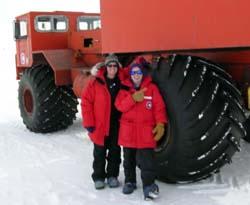
2. Figure 2 - Colleen Brogenski and Jackie Caplan-Auerbach standing next to a Delta tire for scale. The snow vehicles used around McMurdo Station are massive. --

3. Figure 3 - Julie Calkins hones her fire-starting skills on a camping stove. --
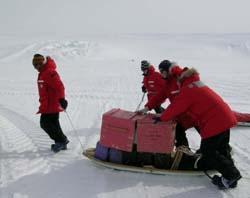
4. Figure 4 - Pulling sleds loaded with our survival equipment out to "Snow Mound City." --
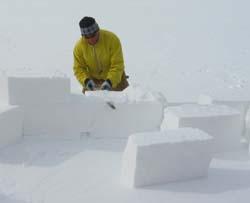
5. Figure 5 - FSTP instructor Brian Johnson demonstrating the finer points of shaping snow blocks for use in walls and igloos. --
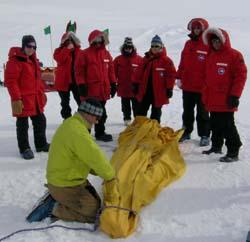
6. Figure 6 - Instruction on how to set up a Scott tent, named for the early Antarctic explorer Robert Falcon Scott. --
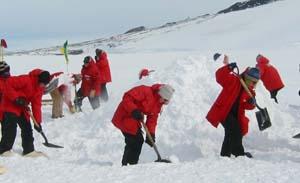
7. Figure 7 - Piling and packing snow on top of sleep kits forms the framework for a snow shelter or "quincy," a warm alternative to a tent. --

8. Figure 8 - Digging an entrance to the snow cave provides an opportunity to warm up, making the big red parka just too hot! --
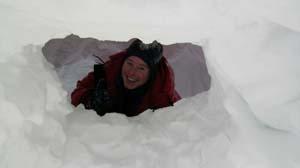
9. Figure 9 - Jackie Caplan-Auerbach examines the inside of the snow cave. --
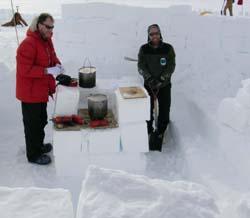
10. Figure 10 - Andy Sajor and Kurt Panter man the snow kitchen, complete with a snow-stove. --
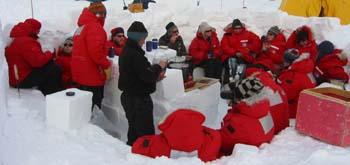
11. Figure 11 - The kitchen quickly became the social hub for the Happy Camper team where we had dinner, drinks (hot cocoa and hot spiced cider), and shared stories. --
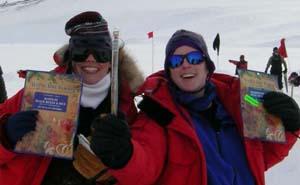
12. Figure 12 - Amy Stolyes and Jackie Caplan-Auerbach examine the survival food options - pepperoni sticks and dehydrated meals - a culinary delight! --
Contact the TEA in the field at
.
If you cannot connect through your browser, copy the
TEA's e-mail address in the "To:" line of
your favorite e-mail package.
|
